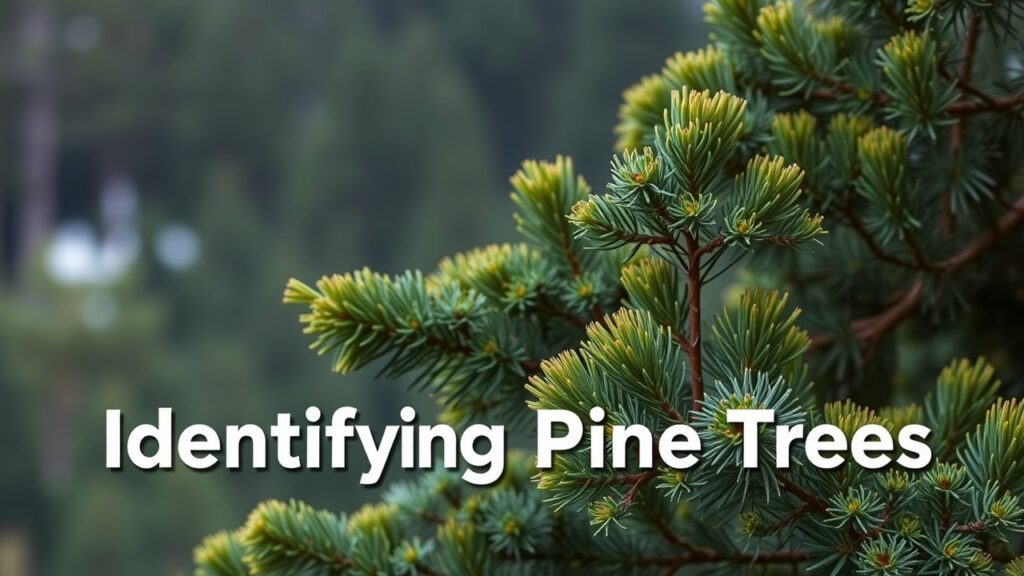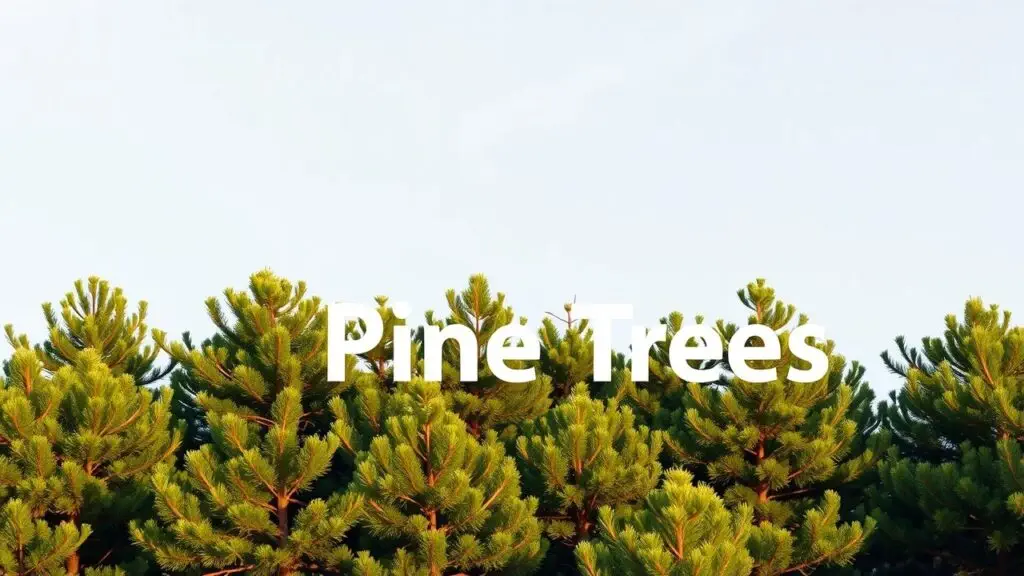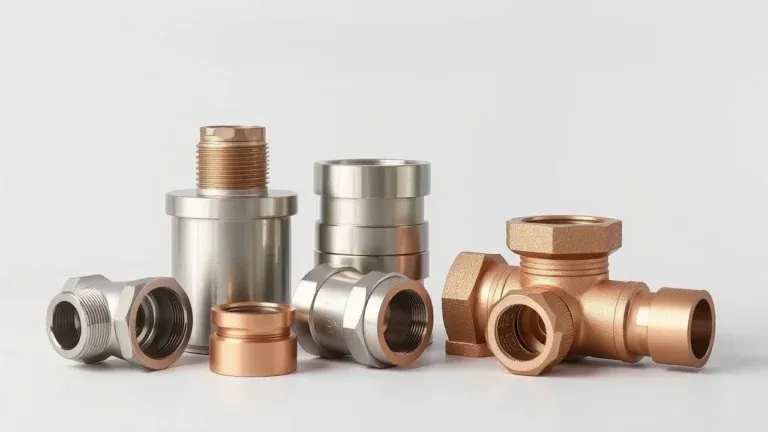Learn to identify types of pine trees, such as the Eastern White Pine and Red Pine. This guide covers many eastern pine species, useful for identifying trees in your yard or while exploring forests and differentiating them from similar trees like spruce and fir.
What Are Pine Trees?

Pine trees are part of the Pinus genus, which falls under the coniferous tree family. These evergreen trees have needle-like leaves and cones that hold seeds. The needles come in different lengths, colors, and shapes based on the species. The bark of pine trees can be thick and scaly or thin and smooth.
Pine trees are very adaptable. They grow well in many places, from cold northern areas to warmer southern ones. Because of this adaptability, they are among the most common types of conifers worldwide.
Overview of Pine Tree Distribution
Pine trees can be found almost everywhere except Antarctica. In North America, they are common in forests across Canada and parts of the U.S., like California’s Sierra Nevada mountains and Florida’s sandy soils. Europe has native species too, such as Scots pine (Pinus sylvestris). In Asia, you’ll find varieties like Japanese red pine (Pinus densiflora) and Korean pine (Pinus koraiensis).
Their ability to grow in many conditions helps pines play important roles in ecosystems around the world.
Why Is Identifying Types of Pine Trees Important?
Identifying different types of pine trees is helpful for many reasons:
- Benefits for Homeowners: Knowing which species do well in your area helps homeowners pick the right plants for their yards.
- Landscaping Uses: Some pines look nice and serve as ornamental trees, while others can provide shade or act as windbreaks.
- Timber Production: Many pine species give high-quality lumber for building homes and furniture; understanding these helps forestry professionals.
- Wildlife Habitats: Pines support biodiversity by offering homes to various wildlife species.
- Other Applications: Some pines produce resin used to make products like turpentine; knowing these types helps with responsible harvesting practices.
Identifying types of pine trees boosts ecological awareness among gardeners, landscapers, arborists, and nature lovers while encouraging careful management of our forests.
How to Identify Different Types of Pine Trees by Needles?
Identifying pine trees is pretty easy if you start with their needles. The way these needles are arranged can tell you a lot about the species.
Needle Arrangement
Pine tree needles usually grow in bundles, which is super important for identification. Here’s how they come:
- Two Needles: Eastern White Pine has long, slender needles in pairs.
- Three Needles: Ponderosa Pine shows groups of three shorter needles.
- Five Needles: Sugar Pine features five long and flexible needles.
Knowing this needle arrangement helps you figure out what type of pine tree you might find.
Needle Length Variations
Needle length can be quite different among various species. Here are some examples:
- Short Needles (1–3 inches): Found on Red Pine and Scots Pine.
- Medium-Length Needles (4–6 inches): Common in Loblolly Pines.
- Long Needles (7+ inches): Longleaf Pines and Sugar Pines have these long ones.
These needle lengths help not only with identification but also give each species a unique look.
Recognizing Cones Across Pine Tree Varieties
Pine cones are also very helpful for identifying different types of pine trees. Their size and shape vary a lot between species, acting as clear markers.
Cone Size and Shape Differences
Pine cones range in size from small to large:
- Small Cones (<2 inches): Often seen on Eastern White Pines.
- Medium Cones (2–5 inches): Typical for Ponderosa Pines.
- Large Cones (>5 inches): Sugar Pines can have cones that grow up to 20 inches long!
Shape matters too; some cones are long while others are round or even cylindrical. Watching these details helps with knowing specific varieties of pines better.
Bark Features That Help Distinguish Pines
Bark is another key feature that helps in recognizing different types of pine trees. The texture and color can change as the tree gets older, revealing much about its identity.
Texture Changes
The texture of bark differs between species:
- Some pines start with smooth bark but become scaly as they get older, like the Loblolly Pine.
- Others keep rough textures throughout their lives, like the Pitch Pine which has deeply furrowed bark.
Color Variations
Bark color changes with age; younger pines may show lighter shades that darken over time. For example, Western Yellow Pines begin grayish-brown and become darker as they mature.
By paying attention to bark features along with needle arrangements and cone characteristics, you’ll improve your chances of correctly identifying various types of pine trees.
Geographic Location
Geographic location is key for understanding where specific types of pine trees grow best. Different areas support various climate zones for different pine species:
North America Distribution
Many common pines like Red Pine grow well in northern climates. Southern Yellow Pines thrive in warmer places such as Florida and Georgia. Knowing these ranges helps people choose the right varieties based on local weather—whether planting ornamental trees or timber forests.
Being aware of features like needle structure, cone shape, bark texture, and geographic location gives you useful tools for identifying diverse types of pine trees in nature.
Common Types of North American Pine Trees
Eastern White Pine (Pinus strobus) Identification Guide
The Eastern White Pine, or Pinus strobus, is a well-known type of pine tree in North America. It has long, slender needles that grow in bundles of five. This gives it a soft look. The tree also produces large cones, which can be 6 to 8 inches long. When young, the bark is smooth and gray but becomes furrowed as it ages.
This tree grows fast and can reach heights of up to 80 feet when fully mature. It does well in well-drained soil and loves sunlight. That makes it a great choice for landscaping projects where height and beauty matter. People also value the Eastern White Pine for timber production because its straight trunk and light wood are useful.
- Physical Characteristics:
- Long slender needles (5 per bundle)
- Large cones
- Smooth gray bark that turns furrowed with age
- Growth Habits:
- Fast-growing
- Mature height up to 80 feet
- Geographic Range & Uses:
- Found mainly in the Northeastern U.S.
- Used for timber production and landscaping
Red Pine (Pinus resinosa) Identification Guide
Red Pine, scientifically known as Pinus resinosa, is another common species across North America. This tree stands out with its needles growing in pairs, typically around 4 to 6 inches long. The reddish-brown bark peels off in thin scales as the tree matures, giving it an interesting look.
Red Pines like sandy soils that drain well. They prefer sunny spots but can handle some shade too. This species is important for reforestation projects since it grows quickly and adapts to different environments.
- Physical Traits:
- Needles grow in pairs
- Reddish bark that peels into thin scales
- Ideal Conditions:
- Sandy soils with good drainage
- Prefers sunny locations but tolerates some shade
- Primary Uses:
- Important for reforestation projects
Loblolly Pine (Pinus taeda) Identification Guide
Loblolly Pine, or Pinus taeda, is famous for being one of the fastest-growing pine trees found in the Southeastern United States. Its thick needles grow in groups of three and can be quite long—sometimes over 10 inches! These features make Loblolly Pines easy to identify. The cones produced are large enough for effective seed dispersal.
These pines do best in moist soil found in lowland areas but can adapt to drier spots after getting established. They serve many purposes, including paper pulp manufacturing because they grow rapidly and produce a high yield.
- Unique Attributes:
- Thick needles (3 per group)
- Large cones suitable for seed dispersal
- Habitat Preferences:
- Thrives in moist soil conditions
- Can adapt to drier sites once established
- Applications:
- Widely used for paper pulp manufacturing
These types of pine trees each have unique features that make them special. They serve different purposes, from enhancing gardens to providing materials for industry like timber production.
Notable European & Asian Pines
Scots Pine (Pinus sylvestris) Profile
The Scots Pine, or Pinus sylvestris, stands out with its reddish-brown bark on the upper trunk. This unique color helps to tell it apart from other pine trees. It grows naturally in Europe and parts of Asia but has also spread to other places worldwide.
People often choose the Scots Pine as a Christmas tree because of its nice shape and the way it keeps its needles for a long time. Besides being pretty, this tree is important for wildlife and helps keep soil stable with its roots. The Scots Pine is also valuable in timber production; its wood is great for building and making furniture.
Japanese Black Pine (Pinus thunbergii) Profile
The Japanese Black Pine, known as Pinus thunbergii, has dark bark that looks cool in gardens. Its long needles can grow up to 10 inches (25 cm) and are found in pairs, which makes it quite special.
This pine tree is popular for landscaping because it can handle tough coastal conditions, like salty air. You’ll often see it near beaches. People also love using the Japanese Black Pine for bonsai since it stays small when trimmed and still looks great.
Other Notable European and Asian Pines
Here are some other interesting pine trees that play a big role in their environments:
- Pinyon Pine (Pinus edulis): This tree produces yummy pine nuts that many people enjoy eating. It thrives in dry areas across the southwestern U.S.
- Swiss Stone Pine (Pinus cembra): Known for its beauty, this tree is great for decoration and can survive cold winters. It looks nice with its even growth pattern.
- Longleaf Pine (Pinus palustris): This species is important because efforts are being made to restore it. Longleaf Pines were once very common but faced major declines due to logging.
These different types of pines not only beautify our landscapes but also support their ecosystems across Europe and Asia.
Factors to Consider
When you pick a pine tree, think about several key things to find the best match for your space. Knowing these factors will help you make a smart choice.
Pine Tree Characteristics
Pine trees have different traits like needle length, cone shape, and bark texture. Here are some common features:
- Needle Type: Pines have long or short needles in clusters. For example, Eastern White Pine has soft, long needles that grow in groups of five.
- Cone Shape: The cones can be small and round or big and long.
- Bark Texture: Bark varies from smooth to rough. Ponderosa Pine has thick plates of bark that look cool.
Soil Types for Pine Trees
Pine trees like certain soil types to grow well. Most pines need soil that drains well and has good air flow. Common soil types include:
- Acidic Soil: Many pines do great in acidic soils (pH below 7), often found under oak or maple trees.
- Sandy Soil: This soil drains well but might need extra nutrients since it can lack organic matter.
Climate Zones for Pine Trees
Knowing your climate zone is key when selecting pine trees. Different species handle temperature extremes differently:
| Climate Zone | Suitable Pine Species |
|---|---|
| Zone 3 | Eastern White Pine |
| Zone 4 | Red Pine (Pinus resinosa) |
| Zone 5 | Loblolly Pine |
| Zone 6 | Japanese Black Pine |
Picking a tree for your zone will help it grow better and live longer.
Selecting the Right Pine Tree
To find the perfect pine tree for your garden or project, check its mature size—height and spread—as well as what you plan to use it for (like pretty decoration or timber). Fast-growing varieties like Loblolly Pines cover space quickly but need more room than smaller types suited for tiny gardens.
By considering characteristics, soil types, and climate zones, you’ll choose from many types of pine trees available today.
Pine Trees for Small Spaces

If you have a small yard or live in an urban area where every bit of space matters, dwarf varieties of pine trees are a smart choice. These compact species fit nicely into tight spots while adding beauty without crowding other plants.
Here are some popular dwarf pines:
- Mugo Pine (Pinus mugo): A small, bushy tree perfect for rock gardens.
- Dwarf Alberta Spruce (Picea glauca ‘Conica’): This one looks like a true pine and stays neat with its pyramidal shape.
- Miniature Stone Mountain Lodgepole (Pinus contorta var latifolia): Great for small spaces due to its slow growth but still looks attractive.
These options let you enjoy greenery even in tight spots.
Pine Trees for Landscaping
If you want to quickly spruce up your landscape with good-looking options, fast-growing pine trees should be at the top of your list. They give shade and add style with their unique shapes and colors.
Some nice ornamental choices are:
- Eastern White Pine (Pinus strobus): Tall and graceful; it makes a stunning focal point.
- Japanese Black Pine (Pinus thunbergii): This tree has dark green leaves; it’s often used in Asian-style gardens because it’s so pretty.
Choosing fast growers helps fill out landscapes efficiently.
Pine Trees for Timber Production
If you’re focusing on timber production rather than just looks, certain pine species stand out because they provide high-quality wood and grow quickly:
- Loblolly Pines (Pinus taeda): These are popular in North America because they grow fast—perfect for lumber and reforestation.
- Slash Pines (Pinus elliottii): Commonly found in the South; they produce strong wood that’s great for construction.
By thinking about these timber-focused choices along with other selection criteria, you’ll set yourself up for success whether planting personally or professionally!
Planting, Care, and Maintenance
Planting Pine Trees
Planting pine trees is exciting! First, pick a good spot. These trees like sunny places with fresh air. You need to check the soil too. They do best in well-drained soils, like sandy or loamy types. If the soil holds water too much, that can hurt them.
You also need to know your hardiness zone. This tells you if your chosen tree will grow well in your climate. Think about how big the tree will get when it’s fully grown. Some pines are tall while others stay smaller. It’s smart to space them apart so they can grow without getting crowded.
Watering and Fertilizing
Watering pine trees is very important when they are young. After you plant them, give them a deep drink of water once a week until they grow strong roots. Once they are settled in, you can water less often but don’t forget during dry times!
Fertilizing is different. Too much can actually be bad for them. Use a balanced fertilizer in spring if you think they need help growing, but be sure to read the package for the right amount based on how old and big your tree is.
Pruning and Shaping
Pruning is all about keeping pine trees healthy and looking nice. Start by cutting off any dead or sick branches. This lets more air into the tree’s leaves and helps prevent problems later.
For younger trees, shaping them correctly is key. Try to give them an open center shape, which helps sunlight reach all parts of the tree. This method supports better growth as they age.
Common Pests and Diseases
Pine trees can have some pests and diseases that cause trouble. One serious disease is white pine blister rust. It mostly affects Eastern White Pine trees, so spotting it early can help keep your tree safe.
Watch out for bark beetles too! These pests can burrow into the trunk and damage it over time. Signs of infestation include sawdust at the base of the tree, which means you may need to take action like using insecticides or introducing natural predators depending on how bad it gets.
FAQs about Types of Pine Trees
What are the main characteristics used to identify pine tree species?
Pine trees can be identified by their needle arrangement, cone size, and bark texture. The number of needles per cluster is important for distinguishing species.
What are some common pine trees in North America?
Common types include Eastern White Pine, Red Pine, Loblolly Pine, and Jack Pine. Each species has unique features and growth habits.
How do I distinguish between different pine species based on their needles?
Look for the number of needles in bundles. For instance, Eastern White Pine has five needles per bundle while Red Pine has two.
What are ideal growing conditions for various types of pine trees?
Most pines prefer well-drained soil and full sunlight. Some species adapt to sandy soils while others thrive in moist conditions.
Are there specific pine trees suitable for landscaping?
Yes, Eastern White Pine and Japanese Black Pine are great options. They enhance beauty and provide shade in gardens.
What common pests affect pine trees?
Pests like bark beetles can harm pines. Regular inspection can help catch infestations early.
Unique Insights on Various Pine Species
Lesser-Known Types of Pine Trees
- Pinus banksiana (Jack Pine): Grows well in sandy soils; important for wildlife habitat.
- Pinus virginiana (Virginia Pine): Adapts to poor soil; useful for reforestation.
- Pinus echinata (Shortleaf Pine): Thrives in mixed forests; serves as a habitat for many birds.
- Pinus lambertiana (Sugar Pine): Known for its long cones; valuable for timber and ornamental uses.
- Pinus jeffreyi (Jeffrey Pine): Has thick bark; can withstand fires better than other pines.
- Pinus radiata (Monterey Pine): Grows quickly; commonly used in forestry plantations.
Ecosystem Roles of Pines
- Biodiversity Support: Pines provide habitats for various wildlife, including birds and mammals.
- Carbon Sequestration: They absorb CO2 from the atmosphere, helping to mitigate climate change.
- Soil Stabilization: Roots prevent erosion by holding soil in place.
- Ecosystem Services: Pines contribute to water filtration and nutrient cycling.
Threats to Pine Trees
- Climate Change: Changes in temperature affect growth patterns and health.
- Pine Tree Diseases: Fungal infections like white pine blister rust threaten certain species.
- Invasive Species: Non-native pests can disrupt local ecosystems and damage native pines.
Additional Uses of Pines
- Wood Products: Used for furniture, paper, and construction materials.
- Aromatherapy: Pine resin is extracted for essential oils with therapeutic benefits.
- Culinary Uses: Certain pine nuts are edible and popular in cooking.
Tips for Growing Healthy Pines
- Choose the right species based on climate zone and space requirements.
- Monitor soil moisture regularly to prevent over or under-watering.
- Prune dead branches yearly to promote healthy growth.
Related Topics
- Types of Pine Needles
- Types of Pine Cones
- Types of Pine Bark
- Types of Soil for Pine Trees
- Types of Climate Zones for Pine Trees
- Types of Dwarf Pine Trees
- Types of Pine Trees for Small Spaces
- Types of Pine Trees for Landscaping
- Types of Pine Trees for Timber Production
- Types of Pine Tree Pests and Diseases
- Types of North American Pine Trees



Types of Pine Trees: Eastern White Pine, Red Pine, and More